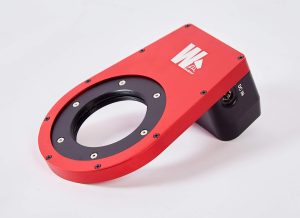The updated Wanderer Astro WandererRotator Mini V2 is a lightweight and ultra low-profile M54 motorized camera rotator. It is capable of high speed and precision, at up to 4.5 degrees/second with better than 0.1 degree accuracy. At only 10mm thick, the Mini rotator is ideal for setups where backfocus is limited.

In the release of the Mini V2 Wanderer Astro has added a 12V power input port which allows the rotator to be powered by 12V instead of directly through the USB port in the previous model. This avoids the problem of most passive hubs not being able to power the rotator. It has a 10mm optical path (from M54 to M54 thread), 420g weight, zero flexure, custom-set zero position and derotation functionality.
The WandererRotator Mini V2 is capable of holding a payload of up to 5kg with a center of gravity 10cm away from the rotator. The magnetic structure design guarantees zero flexure at any altitude. For users of alt-azimuth mounts and Dobsonians field de-rotation is supported. It is ASCOM compatible and can be controlled by modern astrophotography software such as N.I.N.A.
You can learn more about the WandererRotator Mini V2 here.
And to make it easier for you to get the most extensive news, articles and reviews that are only available in the magazine pages of Astronomy Technology Today, we are offering a 1-year magazine subscription for only $6! Or, for an even better deal, we are offering 2 years for only $9. Click here to get these deals which only will be available for a very limited time. You can also check out a free sample issue here.
The Sun is more active than it’s been in years and if that’s not enough, we have the Annular Solar Eclipse on October 14, 2023 and the Total Solar Eclipse on April 8, 2024! If you’d like to learn more about the technology behind solar observing, solar imaging and more, you can check out our new monthly magazine – Solar Astronomy Today. It’s free to read, no subscription needed and available here. And if you are preparing for the upcoming eclipses and want to know your equipment options from solar glasses to the most out of this world solar viewing and imaging options, check out our free publication – The Definitive Guide to Viewing and Imaging the Sun – simply click here and enjoy reading!



